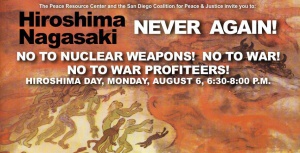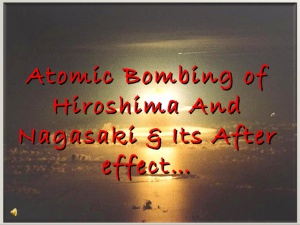
Source: http://www.sdcpj.org/recent.html
Hiroshima Day and the Nagasaki Day are not a days of celebration; these are the days of remembrance of the most unhuman disasters of war. It falls on the 6th and the 9th of August respectively. These were the days when the US had dropped the atom bombs on these populated cities of Japan during the World War II, in order to obtain unconditional surrender of Japan. U.S. President Harry S. Truman ordered these attacks on August 6 and 9, 1945. The atomic bombs had been created through the Manhattan Project and named “little boy” and “fat man”. At least 66,000 people were killed in Hiroshima, while 39,000 were killed in Nagasaki, totaling the deaths to 105,000. Six days after the explosion over Nagasaki, Japan surrendered to the Allied Powers on August 15. Japan signed the surrender paper on September 2. This officially ended the Pacific War and World War II. Partly because of the atomic bombings, after the war, Japan adopted the Three Non-Nuclear Principles. These principles said that Japan could not create or try to get nuclear weapons.
Every August 6, “A-Bomb Day”, the city of Hiroshima holds the Peace Memorial Ceremony to console the victims of the atomic bombs and to pray for the realization of lasting world peace. The ceremony is held in front of the Memorial Cenotaph in the Hiroshima Peace Memorial Park. Participants include the families of the deceased and people from all over the world.
Both Hiroshima and Nagasaki have since rebuilt their cities but reminders of the deadly nuclear blast remain today. The Atomic Bomb Dome at the Hiroshima Peace Memorial Park commemorates those killed.

Source: https://www.slideshare.net/MoiduBhai/atomic-bombing-of-hiroshima-nagasaki
The survivors of the bombings are called hibakusha. The Japanese government has recognized about 650,000 people as hibakusha. As of March 31, 2016, 174,080 are still alive, mostly in Japan. The government of Japan recognizes about 1% of these as having illnesses caused by radiation. The memorials in Hiroshima and Nagasaki contain lists of the names of the hibakusha who are known to have died since the bombings. Updated annually on the anniversaries of the bombings, as of August 2016 the memorials record the names of more than 475,000 hibakusha; 303,195 in Hiroshima and 172,230 in Nagasaki.
The Hiroshima day and Nagasaki day are observed in India also as a day of Peace in India and all over the world. The awareness programs are organized and speeches are delivered to create awareness against nuclear testing and wars, so that such a disastrous event is not repeated in future.
